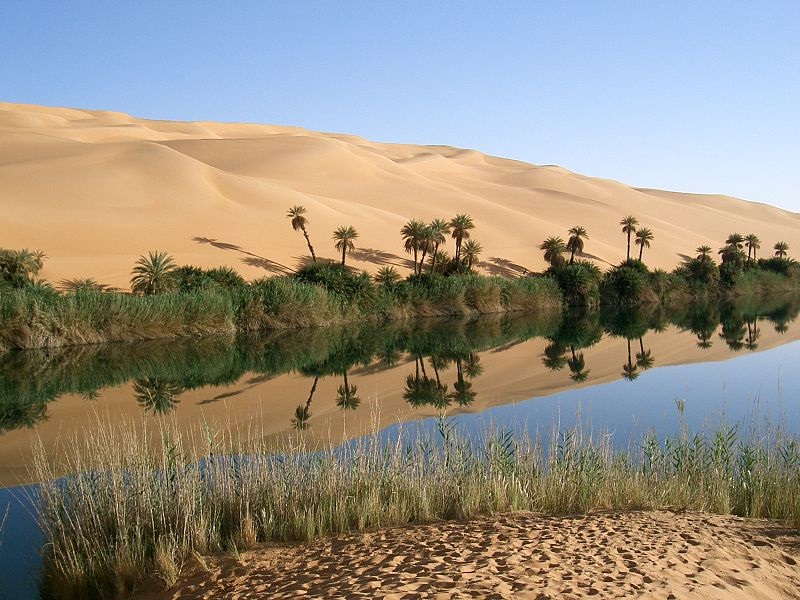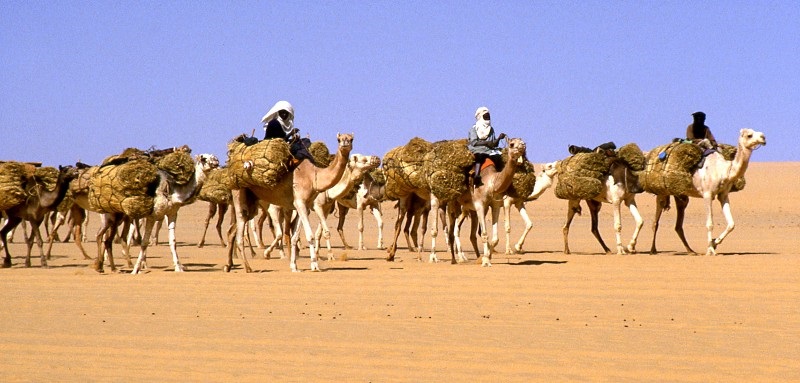Alcafran Desert
The Alcafran Desert (/.ælˈkæf ɹən/, /.æl kəfˈɹaːn/; Nemidi: αλ’Ϙαϕρ ασκαβιρ, riadicised: al’Qafr askabir, “Great Wasteland”) is a vast arid wilderness in southern Heberia. With an area of 1,428,500 wmi2, it is the world’s largest desert, stretching nearly 1,500 wmi from east to west and over 1,200 wmi from north to south. Its total area has fluctuated over time due to cyclical expansion and contraction, particularly along its southwestern edge, caused by the planet’s axial precession, which changes the location, duration and intensity of the South Heberian monsún. At the heart of the Alcafran Desert lies al’Qit-ar’Farig (Nemidi: αλ’Ϙιτ-αρ’Φαριγ, “The Empty Sector”), the largest continuous expanse of sand in the world.
Etymology
The name “Alcafran” is taken from the Nemidic term αλ’Ϙαϕρ (al’Qafr), meaning “the wasteland,” from the root ϙϕρ, which forms words relating to traces of habitation. In its fourth derivation, the stem ϙαϕρ has a negative connotation, suggesting barrenness, waste and desolation.Geography
The Alcafran Desert occupies most of central Nemed as well as portions of Betenos, Farsaidh, Fenios and Jubalcain. It is bordered to the north by Carman Bay and the Haas an’Shahin Mountains, on the east by the Bay of Qian, and in the south by the Nemedian Sea. Along its southwestern margin, a semi-arid belt of tropical savánna known as the Hafa (Nemidi: αλ’Ηαϕα, “edge, brink, border”) forms a transitional zone between the Alcafran to the northeast and more arable land to the southwest.The hyperarid Alcafran is among the world’s most inhospitable regions, with mean high temperatures of 115° - 135° on the Feinheit scale, and precipitation averaging less than one orla annually. It is noted for its near-constant high winds and frequent sandstorms, known locally as Riyahramlia (Nemidi: αλ’Ριυαηραμλια, “Sand Winds”). Yet despite current conditions and appearances, remnants of ancient lakes, and the fossil record they contain, provide evidence of a much greener, more benign environment in the region between 10,000 and 20,000 years ago.
The desert is comprised of three major sections. The eastern half is dominated by an enormous wind-swept sand sea known as al’Qit-ar’Farig1 (“the Empty Sector”), a broad sedimentary basin stretching from Farsaidh to Fenios. It is the largest continuous sand-covered area in the world, encompassing nearly 700,000 wmi2, with dunes reaching over 200 yds in height. The sands which overlie the gipseam and gravel plains are primarily sileacates, made up of 80 to 90% quarz, with the remainder consisting of various feldspats. Iron ocsides within the grains are responsible for the distinctive orange, red and purple landscapes which characterize this part of the region.
The low-lying northwestern portion of the Alcafran Desert, known as the 'ard alMilh (Nemidi: ‘αρδ αλΜιλη, “Salt Land”), consists of a closed basin with many shallow valleys and wadis, which form expansive brackish salt flats during the brief monsún season. As the water evaporates, leaving behind its dissolved minerals, enormous salt pans form on the surface, giving the landscape its distinctive white color. The region is known for its perilous quicksand pools, the most prominent of which is the Om al’Sum.
Between these two low-lying areas, an elevated limestone plateau rises gently in a northeasterly direction from the valleys of the Sherut and Mingur Rivers. Known as the Hadaba (Nemidi: αλ’Τζαβαλ Ηαδαβα, “Plateau Mountain”), the tableland terminates abruptly at the Jab-al’Juruf escarpment. The broad cuesta rises some 600 yds above the desert floor at its eastern edge, while sloping downward gradually to the 'ard alMilh on its western side.
Due to the extremely arid conditions, most of the desert’s drainage channels are either dry or ephemeral. However, despite the lack of precipitation, four aquafer-fed river systems flow perennially through the Alcafran – the Sherut, the Mingur, and the Almirani, which traverse the Hadaba, and the Alsifta, which rises in the Empty Sector at the al’Mijawfia Oasis.
The Quicksands of Om al’Sum
On the western edge of the 'ard alMilh in Al-Khutat Province there is a prodigious quicksand region known as the Om al’Sum (Nemidi: Ωμ-αλ’Συμ, “Mother of Poisons”). Throughout the region, barren salt marshes of concentrated brine and sandy slush lurk beneath a sun-bleached landscape of salty sand. Despite appearances, though, the solid-looking crust can vary in thickness from as much as three yards to as little as three orlaí, and can be extremely treacherous to the unwary traveler, who may not recognize the danger before breaking through and sinking into the morass.
The Jab-al’Juruf Escarpment
The eastern edge of the Hadaba is separated from the al’Qit-ar’Farig by a 500 wmi long series of 600 yds high cliffs called the Jab-al’Juruf (Nemidi: αλ’Τζαβ-αλ’Τζυρυφ, “Mountain of the Scarps”). The great escarpment formed by the uplifting of the Hadaba is a major topographical feature that extends from the foothills of the Haas an’Shahin in Nakah Province, following a gradual arc southward to the Almirani Valley in the Sahabam. Generally, the top of the escarpment is flat and smooth, with a dramatic sharp edge that falls away to expose cliffs with inclines as steep as 70° - 90° for as much as 400 – 500 yds before reaching the more gradual slopes of the talus deposits below.The al’Mijawfia Oasis
In the southwestern section of the Empty Sector, a broad area of lush vegetation stands out against the baren red sands. Over 100,000 dát-pailms surround Lake Ma'an Naqiun, shading the cool clear waters fed by hundreds of artesian springs. Known as the al’Mijawfia (Nemidi: αλ’μια Τζαυαφια, “Underground Water”), it is Nemed’s largest oasis, and the source of the Alsifta River. It is located deep in the desert, 140 wmi northeast of the Hafa, and consists of the main town of ‘alf Nakhil and three surrounding villages – Dhumran, Faradiq and Sukah. Inhabited since prehistoric times, it was an important stop on the ancient Spice Road and remains one of the most important oases in the region.
The Lost City of Sabhadiq
Many Beidúin legends refer to an ancient and powerful trading city located in the eastern portion of the al’Qit-ar’Farig, which was called Sabhadiq (Nemidic: σαβε αλ’Ηαδαύιϙ, “Seven Gardens”). According to the folklore, the city was long ago destroyed by a natural disaster as a punishment for offending the gods, and swallowed up by the sands of the desert, along with an enormous trove of gold, silver and precious gemstones, never to be seen again. An alternative form of the “Lost City” myth asserts that it still exists as a thriving metropolis to this day, but is shielded from the view of outsiders by a supernatural spell, which is seen by its inhabitants as both a blessing and a curse.Flora and Fauna
Due to its hot, dry climate and harsh weather conditions, the region has very little biodiversity. Nevertheless, a limited variety of desert-adapted plant and animal species have managed to survive in certain areas despite the extreme environment. Among these are numerous species of saltbush and sedgegrass, along with several types of endemic trees such as dát-pailms, acaicias and thorntrees, and shrubs such as firebush and desert rós.Animal species include insects like dung-béitels, sand spíodars and scairpeans, reptiles such as cóbras, horned vipers and spiney-tailed lizards, as well as larger animal species, notably gasailles and oirics, hiéanas, jacails, and sand cats. The Nemedian leon and the Janubian sand gasaille, which once roamed the Alcafran in great numbers, are now extinct. No discussion of desert fauna would be complete without mentioning the camall. Although no longer present in the wild, domesticated camalls have been utilized for transportation and other purposes in the region since the second millennium BCS.
Natural Resources
Salt and gipseam have been extracted from the 'ard alMilh and traded throughout the region for centuries, and were at one time the most valuable natural resources produced by the Alcafran Desert, followed in more modern times by sulfar and fosfáits. Somewhat ironically, the Alcafran Desert also covers an enormous aquafer system that has contained a vast quantity of subtellurian groundwater since the Pleistocéin Age. In recent years, efforts to tap this ancient reserve of fossil water have proven to be moderately successful, with hopeful plans to bring additional irrigation to the region in the future.However, the natural resource that has had the most significant social, economic and political impact upon the entire region would not be discovered until 1936. In that year, vast deposits of crude oil2 were detected beneath the sands of the eastern al’Qit-ar’Farig, with commercial peitriliam production commencing the following year. Since then, many new oil fields have been developed in Tel Khanbar province, along with the Misfat Takrir refinery complex at the port of Min al'Rimal on the Bay of Qian. In recent years additional substantial investments have been directed toward the development of natural gas production as well. As a result, the political and economic influence of Nemed on the world stage has been greatly enhanced.
Human Activity
Archeological research reveals human activity in and around the Alcafran Desert for over 2 million years. Numerous paleolithic and neolithic sites have been uncovered throughout the region, as well specific cultural remains spanning the past 3,000 years, which reveal that nomadic tribes have inhabited the desert since the dawn of history. Collectively known as Beidúin (Nemidic: αλ’βαδϝα, “Desert Dweller”), they were traditionally distinguished from the Humjali (Nemidic: Ηυμτζαλι, “One Who Sits”), who lived in more permanent settlements.They share a common language (Nemidic) and tribal culture, and the vast majority are adherents to the Tariq faith. They lead a nomadic lifestyle centered around the herding of goats, sheep and camalls, moving irregularly, depending upon the availability of grazing pastures. Some Beidúin tribes have been known to plant grain along their migration routes. Nearly 100 tribes of 1,000 members or more live in and around the Alcafran Desert. Among the largest Bedouin tribes are the Berbari, Habdiq, Janubi, Sa’ad, Tawariq, Taghlibi and Zuhariq. Within Nemed, the Beidúin remain a majority of the population, although modern lifestyle changes appear to be decreasing their numbers dramatically.
1 The name al’Qit-ar’Farig is not commonly used by the native Beidúin people, who instead refer to the region as ar’Ramaal (Nemidi: αρ’Ραμααλ, “the Sands”).
2 The Alcafran oil fields are estimated to contain the largest peitriliam reserves in the world.








Comments